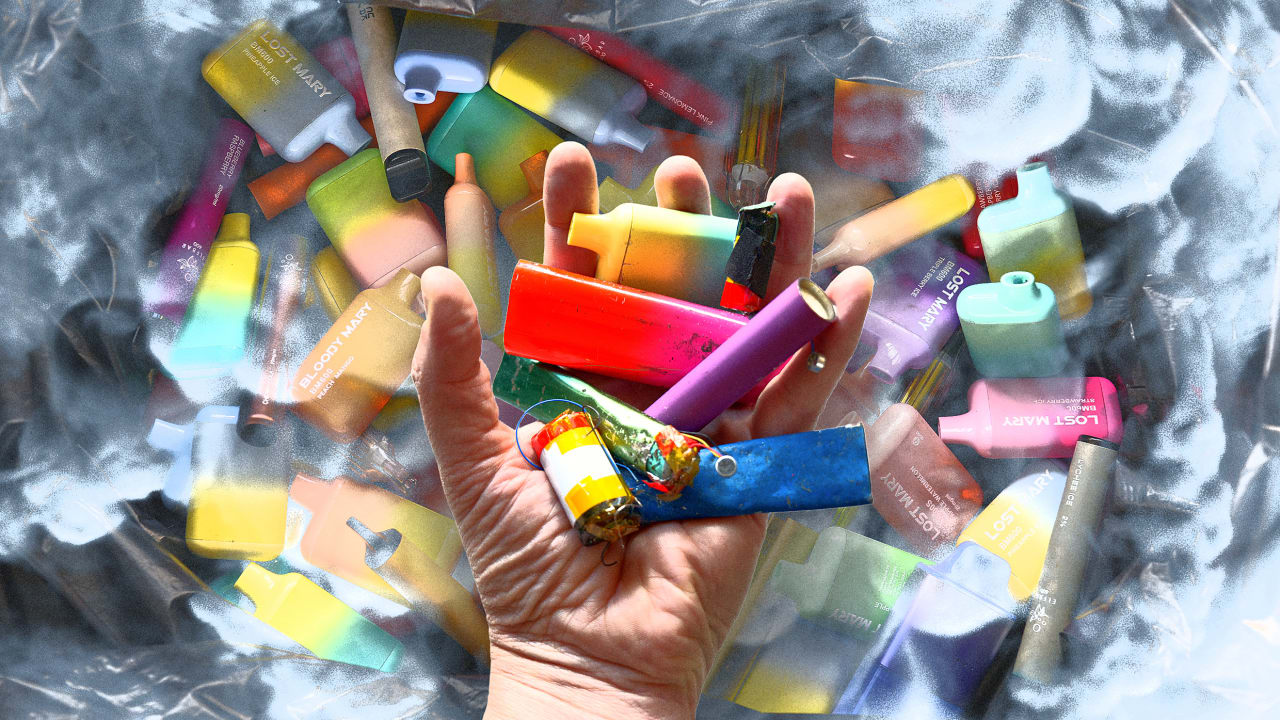Americans throw out 5.7 disposable vapes every second

The majority of e-cigarette sales now come in the form of disposable vapes, meaning that when someone has taken the last puff, that vape—and its lithium ion battery and plastic casing—go right into the trash. Americans now throw away an incredible number of these disposable vapes: nearly 500,000 every day, or about 5.7 vapes per second.
That number comes from the latest vape waste report from the U.S. Public Interest Research Group (PIRG), which looked at 2023 data. And vape waste is increasing, the public advocacy group found. In 2022, U.S. PIRG documented that Americans threw out 4.5 disposable vapes per second.
Disposable vapes are a “particularly insidious” form of pollution for a few reasons, says Lucas Gutterman, the Designed to Last campaign director with PIRG. For one, these devices contain nicotine, a toxic chemical that can leach into water and soil, harming wildlife and ecosystems. They’re also made of plastic that isn’t recyclable, and which also spreads toxins and microplastics into the environment.
Increasingly, disposable vapes double as digital gadgets, with screens that show animations or include built-in games or speakers to play music. That means all this trash is a type of electronic waste, so each disposable vape tossed is like “throwing away miniature computers after a few days of use,” Gutterman says.
Those lithium ion batteries in disposable vapes are made using critical minerals that require mining. Laptops, cellphones, and electric vehicles all use lithium ion batteries too. The amount of lithium used in the batteries of disposable vapes sold every year weighs nearly 30 tons, according to U.S. PIRG—equivalent to the amount of lithium needed to create 3,350 EV batteries. Mining is also tied to human rights abuses, and in 2023, a TikToker explained in a viral video that she was quitting vaping as a way to help people in Congo, which currently supplies 70% of the world’s mined cobalt.
When disposable vapes are tossed into the trash and make their way to recycling and waste facilities, those lithium ion batteries can also cause fires because the devices get caught and crushed in machinery. The report estimates that disposable vapes cause $95 million of damage from waste facility fires each year.
When disposal vapes don’t go into these facilities, they can pollute the environment directly. If a disposable vape is tossed on the street, it can be swept into a storm drain, travel through streams and rivers, and end up in the ocean or along the coast. Predictably, disposable vapes are becoming a dominant source of beach pollution: According to the Surfrider Foundation, from 2021 to 2024 volunteers have seen a 150% increase in vapes among litter collected during beach cleanups.
Disposable vapes are a serious threat, says Kelsey Lamp, oceans campaign director with the Environment America Research & Policy Center, because they include three types of waste in one: “They’re hazardous waste, since they contain nicotine and heavy metals; they’re electronic waste with batteries and circuits; and they’re plastic waste that never biodegrades,” she says.
Studies have found that vape liquids decrease the hatching success of fish embryos and cause DNA damage, among other effects, plus the plastic casings can both carry toxins and break down into microplastics.
Some states are taking action against disposable vapes. California banned flavored tobacco products, which led to a 52% decrease in disposable vape sales. Massachusetts also banned flavored e-cigarettes, resulting in a 74% drop in disposable vape sales. But Lamp and U.S. PIRG urge legislators to take more action and ban disposable vapes across the country.
“We wouldn’t dump 30 tons of lithium directly into our ocean. We wouldn’t pour thousands of pounds of nicotine into our waterways. Yet that’s exactly what we’re doing by allowing disposable vapes to pollute our waterways,” Lamp says. “Our oceans are already under pressure from rising temperatures, overfishing, and land-based pollution. We cannot afford to add this entirely preventable source of toxic waste to the mix.”
What's Your Reaction?
 Like
0
Like
0
 Dislike
0
Dislike
0
 Love
0
Love
0
 Funny
0
Funny
0
 Angry
0
Angry
0
 Sad
0
Sad
0
 Wow
0
Wow
0






























































































